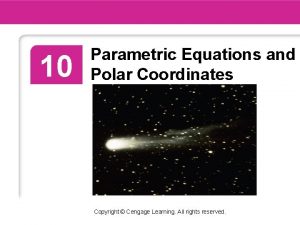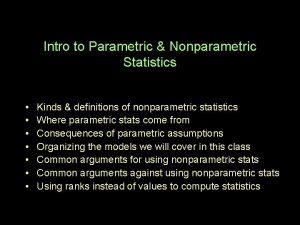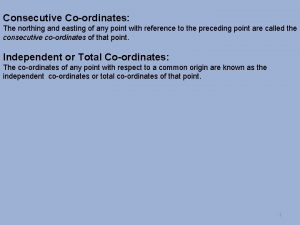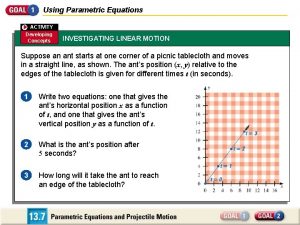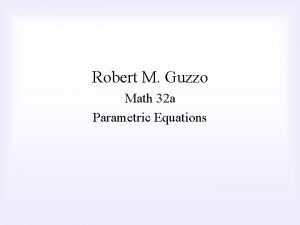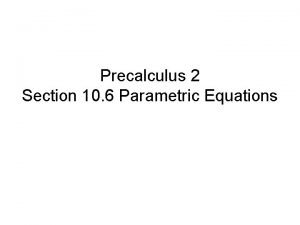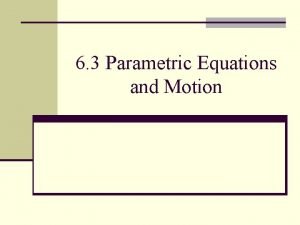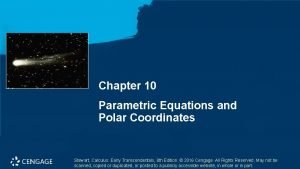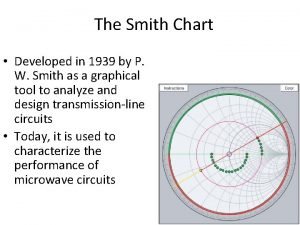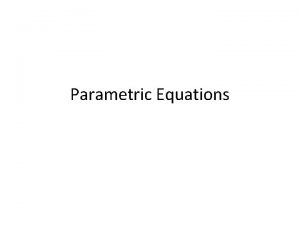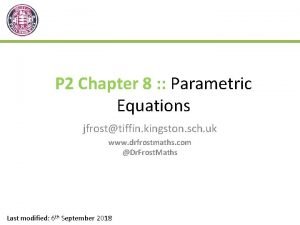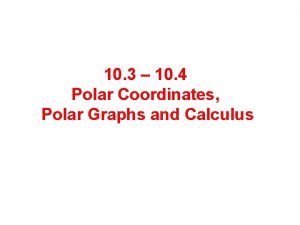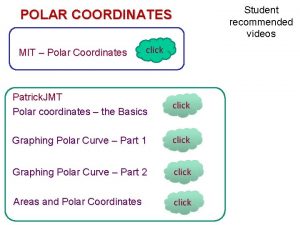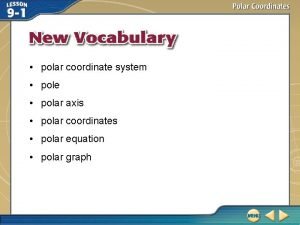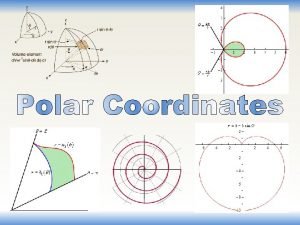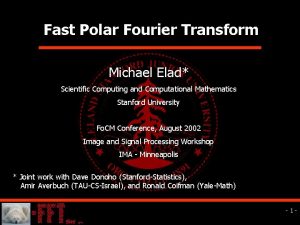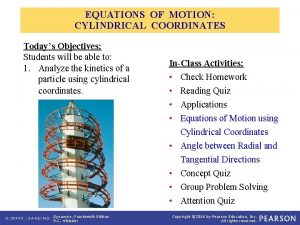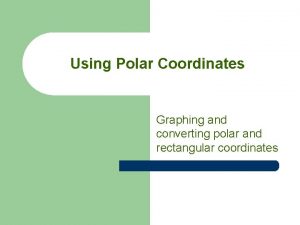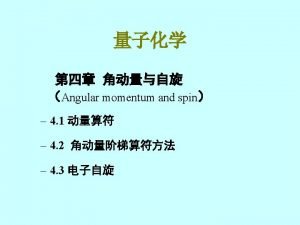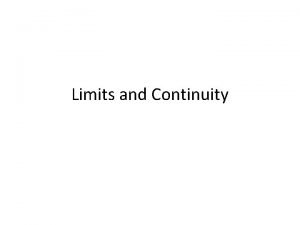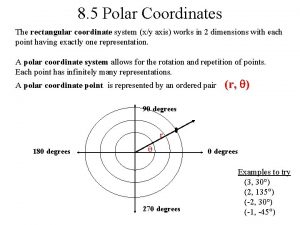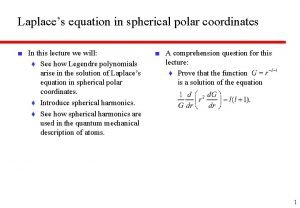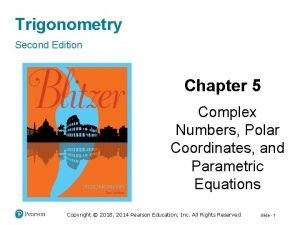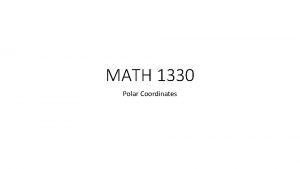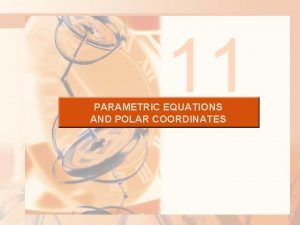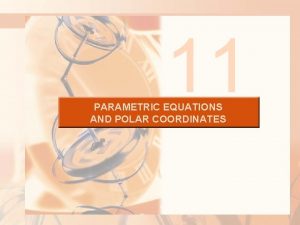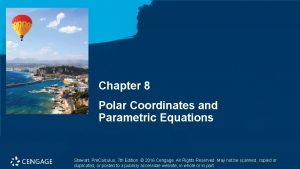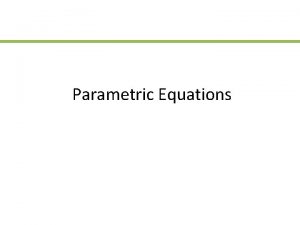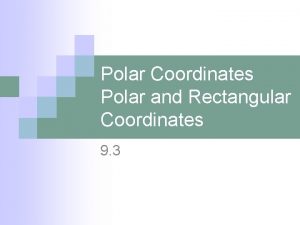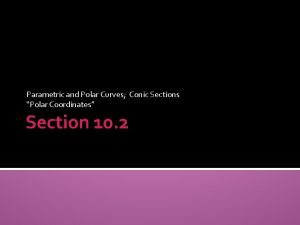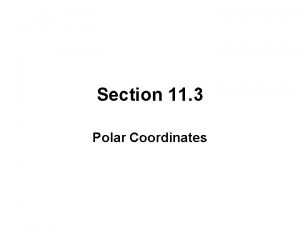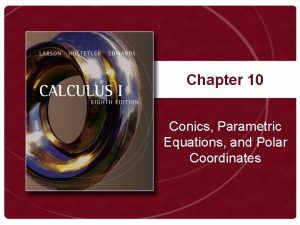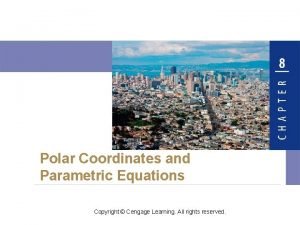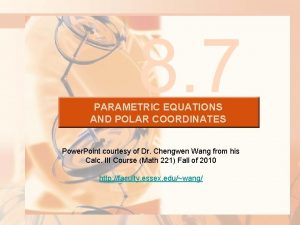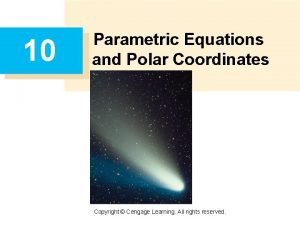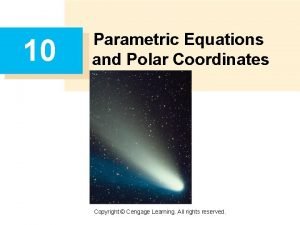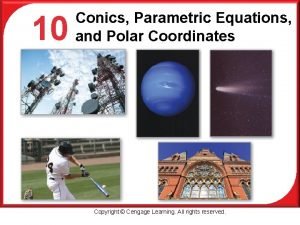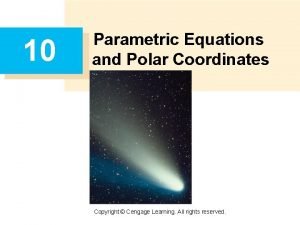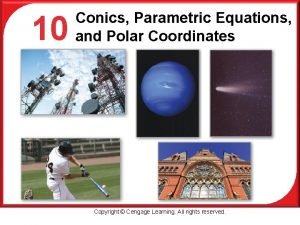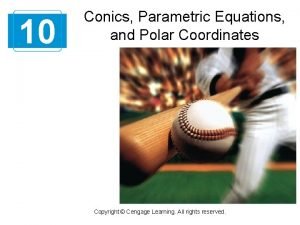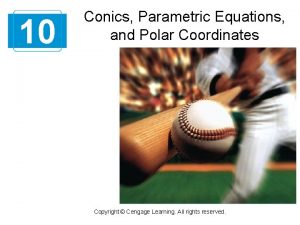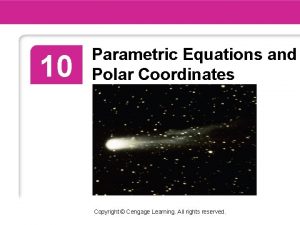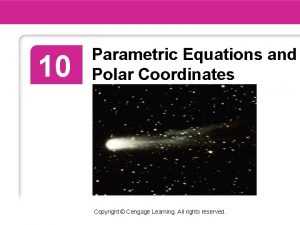Chapter 10 Parametric Equations and Polar Coordinates Stewart



































- Slides: 35

Chapter 10 Parametric Equations and Polar Coordinates Stewart, Calculus: Early Transcendentals, 8 th Edition. © 2016 Cengage. All Rights Reserved. May not be scanned, copied or duplicated, or posted to a publicly accessible website, in whole or in part.

10. 2 Calculus with Parametric Curves Stewart, Calculus: Early Transcendentals, 8 th Edition. © 2016 Cengage. All Rights Reserved. May not be scanned, copied or duplicated, or posted to a publicly accessible website, in whole or in part.

Tangents Stewart, Calculus: Early Transcendentals, 8 th Edition. © 2016 Cengage. All Rights Reserved. May not be scanned, copied or duplicated, or posted to a publicly accessible website, in whole or in part.

Tangents (1 of 3) Suppose f and g are differentiable functions and we want to find the tangent line at a point on the parametric curve x = f(t), y = g(t), where y is also a differentiable function of x. Then the Chain Rule gives Stewart, Calculus: Early Transcendentals, 8 th Edition. © 2016 Cengage. All Rights Reserved. May not be scanned, copied or duplicated, or posted to a publicly accessible website, in whole or in part.

Tangents (2 of 3) If we can solve for Equation 1 (which you can remember by thinking of canceling the dt’s) enables of the tangent to a parametric curve without having us to find the slope to eliminate the parameter t. Stewart, Calculus: Early Transcendentals, 8 th Edition. © 2016 Cengage. All Rights Reserved. May not be scanned, copied or duplicated, or posted to a publicly accessible website, in whole or in part.

Tangents (3 of 3) We see from (1) that the curve has a horizontal tangent when (provided that and it has a vertical tangent when (provided that This information is useful for sketching parametric curves. It is also useful to consider in Equation 1: This can be found by replacing y by Stewart, Calculus: Early Transcendentals, 8 th Edition. © 2016 Cengage. All Rights Reserved. May not be scanned, copied or duplicated, or posted to a publicly accessible website, in whole or in part.

Example 1 A curve C is defined by the parametric equations (a) Show that C has two tangents at the point (3, 0) and find their equations. (b) Find the points on C where the tangent is horizontal or vertical. (c) Determine where the curve is concave upward or downward. (d) Sketch the curve. Stewart, Calculus: Early Transcendentals, 8 th Edition. © 2016 Cengage. All Rights Reserved. May not be scanned, copied or duplicated, or posted to a publicly accessible website, in whole or in part.

Example 1 – Solution (1 of 5) (a) Notice that (3, 0) on C arises from two values of the parameter, This indicates that C crosses itself at (3, 0). Therefore the point Stewart, Calculus: Early Transcendentals, 8 th Edition. © 2016 Cengage. All Rights Reserved. May not be scanned, copied or duplicated, or posted to a publicly accessible website, in whole or in part.

Example 1 – Solution (2 of 5) Since the slope of the tangent when of the tangents at (3, 0) are so the equations Stewart, Calculus: Early Transcendentals, 8 th Edition. © 2016 Cengage. All Rights Reserved. May not be scanned, copied or duplicated, or posted to a publicly accessible website, in whole or in part.

Example 1 – Solution (3 of 5) (b) C has a horizontal tangent when Since that is, when this happens when The corresponding points on C are (1, − 2) and (1, 2). C has a vertical tangent when that is, t = 0. (Note that The corresponding point on C is (0, 0). Stewart, Calculus: Early Transcendentals, 8 th Edition. © 2016 Cengage. All Rights Reserved. May not be scanned, copied or duplicated, or posted to a publicly accessible website, in whole or in part.

Example 1 – Solution (4 of 5) (c) To determine concavity we calculate the second derivative: Thus the curve is concave upward when t > 0 and concave downward when t < 0. Stewart, Calculus: Early Transcendentals, 8 th Edition. © 2016 Cengage. All Rights Reserved. May not be scanned, copied or duplicated, or posted to a publicly accessible website, in whole or in part.

Example 1 – Solution (5 of 5) (d) Using the information from parts (b) and (c), we sketch C in Figure 1 Stewart, Calculus: Early Transcendentals, 8 th Edition. © 2016 Cengage. All Rights Reserved. May not be scanned, copied or duplicated, or posted to a publicly accessible website, in whole or in part.

Areas Stewart, Calculus: Early Transcendentals, 8 th Edition. © 2016 Cengage. All Rights Reserved. May not be scanned, copied or duplicated, or posted to a publicly accessible website, in whole or in part.

Areas We know that the area under a curve y = F(x) from a to b is where F(x) ≥ 0. If the curve is traced out once by the parametric equations x = f(t) and y = g(t), α ≤ t ≤ β, then we can calculate an area formula by using the Substitution Rule for Definite Integrals as follows: Stewart, Calculus: Early Transcendentals, 8 th Edition. © 2016 Cengage. All Rights Reserved. May not be scanned, copied or duplicated, or posted to a publicly accessible website, in whole or in part.

Example 3 Find the area under one arch of the cycloid (See Figure 3. ) Figure 3 Stewart, Calculus: Early Transcendentals, 8 th Edition. © 2016 Cengage. All Rights Reserved. May not be scanned, copied or duplicated, or posted to a publicly accessible website, in whole or in part.

Example 3 – Solution (1 of 2) One arch of the cycloid is given by 0 ≤ θ ≤ 2π. Using the Substitution Rule with y = r(1 − cos θ) and dx = r(1 − cos θ)dθ, we have Stewart, Calculus: Early Transcendentals, 8 th Edition. © 2016 Cengage. All Rights Reserved. May not be scanned, copied or duplicated, or posted to a publicly accessible website, in whole or in part.

Example 3 – Solution (2 of 2) Stewart, Calculus: Early Transcendentals, 8 th Edition. © 2016 Cengage. All Rights Reserved. May not be scanned, copied or duplicated, or posted to a publicly accessible website, in whole or in part.

Arc Length Stewart, Calculus: Early Transcendentals, 8 th Edition. © 2016 Cengage. All Rights Reserved. May not be scanned, copied or duplicated, or posted to a publicly accessible website, in whole or in part.

Arc Length (1 of 9) We already know how to find the length L of a curve C given in the form y = F(x), a ≤ x ≤ b. If is continuous, then Suppose that C can also be described by the parametric equations x = f(t) and y = g(t), α ≤ t ≤ β, where Stewart, Calculus: Early Transcendentals, 8 th Edition. © 2016 Cengage. All Rights Reserved. May not be scanned, copied or duplicated, or posted to a publicly accessible website, in whole or in part.

Arc Length (2 of 9) This means that C is traversed once, from left to right, as t increases from α to β and f(α) = a, f(β) = b. Putting Formula 1 into Formula 2 and using the Substitution Rule, we obtain Since we have Stewart, Calculus: Early Transcendentals, 8 th Edition. © 2016 Cengage. All Rights Reserved. May not be scanned, copied or duplicated, or posted to a publicly accessible website, in whole or in part.

Arc Length (3 of 9) Even if C can’t be expressed in the form y = F(x), Formula 3 is still valid but we obtain it by polygonal approximations. We divide the parameter interval [α, β] into n subintervals of equal width Δt. If t 0, t 1, t 2, . . . , tn are the endpoints of these subintervals, then xi = f(ti) and yi = g(ti) are the coordinates of points Pi(xi, yi) that lie on C and the polygon with vertices P 0, P 1, . . . , Pn approximates C. (See Figure 4. ) Figure 4 Stewart, Calculus: Early Transcendentals, 8 th Edition. © 2016 Cengage. All Rights Reserved. May not be scanned, copied or duplicated, or posted to a publicly accessible website, in whole or in part.

Arc Length (4 of 9) We define the length L of C to be the limit of the lengths of these approximating polygons as n ∞: The Mean Value Theorem, when applied to f on the interval [ti − 1, ti], gives a number ti* in (ti − 1, ti) such that Stewart, Calculus: Early Transcendentals, 8 th Edition. © 2016 Cengage. All Rights Reserved. May not be scanned, copied or duplicated, or posted to a publicly accessible website, in whole or in part.

Arc Length (5 of 9) If we let Δxi = xi − 1 and Δyi = yi − 1, this equation becomes Similarly, when applied to g, the Mean Value Theorem gives a number ti** in (ti − 1, ti) such that Stewart, Calculus: Early Transcendentals, 8 th Edition. © 2016 Cengage. All Rights Reserved. May not be scanned, copied or duplicated, or posted to a publicly accessible website, in whole or in part.

Arc Length (6 of 9) Therefore and so Stewart, Calculus: Early Transcendentals, 8 th Edition. © 2016 Cengage. All Rights Reserved. May not be scanned, copied or duplicated, or posted to a publicly accessible website, in whole or in part.

Arc Length (7 of 9) The sum in (4) resembles a Riemann sum for the function but it is not exactly a Riemann sum because ti* ≠ ti** in general. Nevertheless, if are continuous, it can be shown that the limit in (4) is the same as if ti* and ti** were equal, namely, Stewart, Calculus: Early Transcendentals, 8 th Edition. © 2016 Cengage. All Rights Reserved. May not be scanned, copied or duplicated, or posted to a publicly accessible website, in whole or in part.

Arc Length (8 of 9) Thus, using Leibniz notation, we have the following result, which has the same form as Formula 3. 5 Theorem If a curve C is described by the parametric equations x = f(t), y = g(t), α ≤ t ≤ β). where are continuous on [α, β] and C is traversed exactly once as t increases from α to β, then the length of C is Notice that the formula in Theorem 5 is consistent with the general formulas Stewart, Calculus: Early Transcendentals, 8 th Edition. © 2016 Cengage. All Rights Reserved. May not be scanned, copied or duplicated, or posted to a publicly accessible website, in whole or in part.

Arc Length (9 of 9) Notice that the integral gives twice the arc length of the circle because as t increases from 0 to 2π, the point (sin 2 t, cos 2 t) traverses the circle twice. In general, when finding the length of a curve C from a parametric representation, we have to be careful to ensure that C is traversed only once as t increases from α to β. Stewart, Calculus: Early Transcendentals, 8 th Edition. © 2016 Cengage. All Rights Reserved. May not be scanned, copied or duplicated, or posted to a publicly accessible website, in whole or in part.

Example 5 Find the length of one arch of the cycloid x = r(θ − sin θ), y = r(1 − cos θ). Solution: From Example 3 we see that one arch is described by the parameter interval 0 ≤ θ ≤ 2π. Since Stewart, Calculus: Early Transcendentals, 8 th Edition. © 2016 Cengage. All Rights Reserved. May not be scanned, copied or duplicated, or posted to a publicly accessible website, in whole or in part.

Example 5 – Solution (1 of 3) We have Stewart, Calculus: Early Transcendentals, 8 th Edition. © 2016 Cengage. All Rights Reserved. May not be scanned, copied or duplicated, or posted to a publicly accessible website, in whole or in part.

Example 5 – Solution (2 of 3) To evaluate this integral we use the identity which gives Since 0 θ 2π, we have and so Therefore Stewart, Calculus: Early Transcendentals, 8 th Edition. © 2016 Cengage. All Rights Reserved. May not be scanned, copied or duplicated, or posted to a publicly accessible website, in whole or in part.

Example 5 – Solution (3 of 3) and so Stewart, Calculus: Early Transcendentals, 8 th Edition. © 2016 Cengage. All Rights Reserved. May not be scanned, copied or duplicated, or posted to a publicly accessible website, in whole or in part.

Surface Area Stewart, Calculus: Early Transcendentals, 8 th Edition. © 2016 Cengage. All Rights Reserved. May not be scanned, copied or duplicated, or posted to a publicly accessible website, in whole or in part.

Surface Area Suppose the curve c given by the parametric equations x = f(t), y = g(t), α ≤ t ≤ β, where are continuous, g(t) ≥ 0, is rotated about the x-axis. If C is traversed exactly once as t increases from α to β, then the area of the resulting surface is given by The general symbolic formulas but for parametric curves we use are still valid, Stewart, Calculus: Early Transcendentals, 8 th Edition. © 2016 Cengage. All Rights Reserved. May not be scanned, copied or duplicated, or posted to a publicly accessible website, in whole or in part.

Example 6 Show that the surface area of a sphere of radius r is Solution: The sphere is obtained by rotating the semicircle about the x-axis. Therefore, from Formula 6, we get Stewart, Calculus: Early Transcendentals, 8 th Edition. © 2016 Cengage. All Rights Reserved. May not be scanned, copied or duplicated, or posted to a publicly accessible website, in whole or in part.

Example 6 – Solution Stewart, Calculus: Early Transcendentals, 8 th Edition. © 2016 Cengage. All Rights Reserved. May not be scanned, copied or duplicated, or posted to a publicly accessible website, in whole or in part.
 Parametric equations and polar coordinates
Parametric equations and polar coordinates Site:slidetodoc.com
Site:slidetodoc.com Univariate analysis tests
Univariate analysis tests Parametric test and non parametric test
Parametric test and non parametric test Boris epshtein
Boris epshtein Parametric vs non parametric test
Parametric vs non parametric test Chapter 7 conic sections and parametric equations
Chapter 7 conic sections and parametric equations Consecutive coordinates
Consecutive coordinates Perspective geometry
Perspective geometry Polar and rectangular forms of equations
Polar and rectangular forms of equations In a pumpkin tossing contest in morton illinois
In a pumpkin tossing contest in morton illinois Parametric equations word problems
Parametric equations word problems Rectangular equation
Rectangular equation Parametric equation of motion
Parametric equation of motion How to solve parametric equations
How to solve parametric equations Smith chart parametric equations
Smith chart parametric equations Parametric equations
Parametric equations Dr frost parametric equations
Dr frost parametric equations Rectangular and polar coordinates
Rectangular and polar coordinates Pole in polar coordinates
Pole in polar coordinates Polar coordinates
Polar coordinates Calculator art project
Calculator art project Initial line of cardioid
Initial line of cardioid Geodesic polar coordinates
Geodesic polar coordinates Polar fourier series
Polar fourier series Equation of motion cylindrical coordinates
Equation of motion cylindrical coordinates How to convert polar form to rectangular form
How to convert polar form to rectangular form Polar equation symmetry
Polar equation symmetry Y=rsin
Y=rsin Type of conic
Type of conic Continuity of a function
Continuity of a function Polar coordinates to rectangular
Polar coordinates to rectangular Double integral polar coordinates
Double integral polar coordinates Laplace equation in spherical polar coordinates
Laplace equation in spherical polar coordinates Conic section in polar coordinates
Conic section in polar coordinates How to find polar coordinates
How to find polar coordinates
